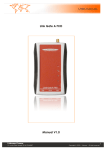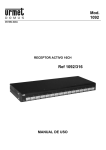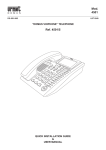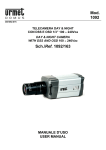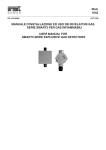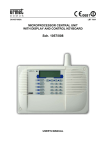Download LBT 8424.indd
Transcript
Mod. 4203 DS 4203-001 LBT 8424 INTERFACCIA GSM DOMUS CELL BASIC GSM INTERFACE DOMUS CELL BASIC Sch./Ref. 4203/1 ell S C ic MU bas DO MANUALE UTENTE USER MANUAL ITALIANO NOTE INFORMATIVE DICHIARAZIONE DI CONFORMITÀ La società Urmet Domus S.p.A. con sede in via Bologna n° 188/C – 10154 Torino (TO) I, dichiara che il presente dispositivo soddisfa i requisiti della Direttiva 1999/5/CE del parlamento Europeo e del Consiglio del 9 marzo 1999 riguardante le apparecchiature radio, le apparecchiature terminali di telecomunicazioni e il reciproco riconoscimento della loro conformità. La conformità a questi requisiti viene espressa mediante la marcatura 0051 USO PER CUI IL DISPOSITIVO È DESTINATO Questo dispositivo è stato progettato e costruito per essere utilizzato come trasduttore da telefonia analogica a telefonia digitale wireless GSM. Pertanto la sua installazione all’interno di impianti PABX, nonché la sua programmazione – laddove necessaria – deve essere eseguita da personale qualificato. IMBALLO Verificare che l’imballo ed il contenuto non presentino danni visibili. Se alcune parti non sono presenti o risultano danneggiate, contattare immediatamente il rivenditore. In questi casi non tentare di utilizzare il dispositivo. In caso il prodotto debba essere rimandato al fornitore, assicurarsi di spedirlo con il suo imballo originale. AVVERTENZE Per un funzionamento sicuro ed efficace del prodotto, si raccomanda di leggere attentamente le seguenti istruzioni prima dell’utilizzo. Il prodotto può essere impiegato esclusivamente per l’uso per il quale è stato concepito e costruito. Qualsiasi altra forma di impiego è da considerarsi a totale responsabilità dell’utilizzatore. L’installazione, programmazione e messa in funzione è consentita solamente ad operatori qualificati. La messa in funzione, deve essere eseguita solamente dopo una corretta installazione, pertanto l’utilizzatore deve provvedere ad effettuare con cura tutte le operazioni descritte nei manuali in dotazione. “URMET DOMUS” non si riterrà responsabile di inconvenienti, rotture, incidenti, ecc. dovuti alla non conoscenza o alla mancata applicazione delle prescrizioni indicate. Lo stesso dicasi per eventuali modifiche non autorizzate. “URMET DOMUS” si riserva il diritto di modificare il prodotto, per qualsiasi esigenza di carattere costruttivo o commerciale, senza l’obbligo di aggiornare tempestivamente i manuali di riferimento. Il dispositivo “DOMUS Cell basic” utilizza lo standard GSM per la telefonia cellulare; non può essere quindi impiegato in zone che si trovano al di fuori dell’area di copertura del sistema stesso. Dato che il sistema GSM è una tecnologia a radiofrequenza (RF), vi possono essere interferenze in presenza di altri apparecchi telefonici o problemi nel funzionamento di dispositivi elettronici insufficientemente protetti dall’energia a radiofrequenza. È VIETATO L’USO DEL “DOMUS CELL”: • In aereo. • In ospedali e centri di cura. • Nelle vicinanze di distributori di carburante o dove sia presente un pericolo di esplosione. • Nei siti dove si opera con agenti chimici in genere, e con particolare attenzione alle norme di sicurezza per ambienti saturi (o potenzialmente saturi) di gas o esalazioni volatili. • In luoghi dove siano in corso operazioni di detonazione. • Nei pressi di apparati elettromedicali, compresi sistemi di ausilio personali come: pacemakers e apparecchi elettroacustici (hearing aids). Il prodotto è comunque conforme agli standard di sicurezza per quanto riguarda l’esposizione all’energia a radiofrequenza. 2 DS4203-001 CONSIGLI PER LA COLLOCAZIONE DELL’INTERFACCIA GSM È preferibile collocare l’interfaccia GSM in ambienti protetti con un campo di temperatura compreso tra 5 e 40°C ed una umidità relativa compresa tra 20 e 75%. Evitare di esporre l’interfaccia GSM direttamente ai raggi solari o a fonti di calore. CONTENUTO DELLA CONFEZIONE • n. 1 apparato DOMUS Cell basic • n. 1 alimentatore da rete 230 Vac • n. 1 antenna • n. 1 cavo USB • n. 1 CD-ROM • n. 1 libretto “DIRITTI DEI CONSUMATORI” • n. 1 libretto “INFORMATIVA SMALTIMENTO RAEE” • n. 1 libretto istruzioni Urmet Domus si riserva il diritto di modificare senza preavviso le specifiche e le prestazioni del prodotto. DS4203-001 3 INDICE GENERALITÀ .................................................................................................................................................. 5 Applicazioni ................................................................................................................................................ 5 Il Domus Cell basic consente ..................................................................................................................... 5 Caratteristiche tecniche.............................................................................................................................. 5 INSTALLAZIONE............................................................................................................................................. 6 Fissaggio a muro ........................................................................................................................................ 6 Collegamento dell’antenna ......................................................................................................................... 6 Collegamento della linea telefonica ............................................................................................................ 7 Inserimento della Sim-card......................................................................................................................... 7 Collegamento dell’alimentatore .................................................................................................................. 8 PROGRAMMAZIONE ..................................................................................................................................... 8 Programmazione da telefono ..................................................................................................................... 8 Programmazione con applicativo ............................................................................................................. 11 INDICAZIONI OTTICHE ................................................................................................................................ 11 4 DS4203-001 GENERALITÀ APPLICAZIONI • • • • • Telefonia in postazioni remote (WLL: wireless local loop). Risparmio sui costi telefonici: collegamento a PABX aziendale. Linee telefoniche di back up. Postazioni telefoniche temporanee. Sicurezza: collegamento a combinatori telefonici. IL DOMUS CELL BASIC CONSENTE • • • • • • Instradamento comunicazioni voce tra linea analogica e rete GSM Collegamento a linea urbana analogica di PABX o telefono BCA Selezione DTMF e decadica CLI (Identificativo del chiamante) a standard FSK BT, FSK Bell e DTMF Blocco delle chiamate uscenti Programmazione da telefono o PC CARATTERISTICHE TECNICHE Meccaniche: Dimensioni: Peso: Installazione: Contenitore: Antenna: Connettore antenna: 94mm x 64mm x 29mm (escluso antenna) 105g massimi (escluso adapter) A muro con tassello ad espansione Plastico Esterna SMA femmina Ambientali: Temperatura di funzionamento: Umidità: Alimentazione: Adapter: Ingresso: Uscite: Potenza massima assorbita: Linea telefonica analogica: Connettore di linea telefonica: Tensione a riposo: Corrente di loop: Selezione in ingresso: Tensione di chiamata: Toni: Massima resistenza di linea: Inversione della polarità: Impulsi di tassazione: CLI: Massima lunghezza di linea: GSM: Profilo: Banda: SIM: USB: Tipo: DS4203-001 Da + 5°C a +40°C Da 10 a 80% non condensata 230Vac ± 10% 7,8Vac / 300mA 27Vac / 100mA 55Vac / 40mA 15VA RJ11 6 posizioni e 2 contatti 24Vdc 38mA max DTMF / decadica 55Vrms 50Hz 425Hz 500Ω si 12/16KHz FSK Bell/FSK BT/DTMF 200 metri Dual band 900/1800MHz 3V e 1,8V Versione 1.1 5 INSTALLAZIONE FISSAGGIO A MURO Scegliere la posizione maggiormente idonea per il fissaggio a muro avendo cura di posizionare l’antenna nel punto di maggiore campo, per verificare l’intensità del campo vedere nei paragrafi “Indicazioni ottiche” oppure “Programmazione”, dopo aver scelto la posizione ottimale per l’antenna scegliere l’ubicazione per il DOMUS Cell basic e fissare a muro il tassello ad espansione avendo cura di lasciare la testa della vite staccata, dal muro, di circa 4mm. ell S C ic MU bas DO COLLEGAMENTO DELL’ANTENNA Avvitare il connettore del cavo dell’antenna al connettore posto sulla parte superiore del DOMUS Cell basic. ell S C ic MU bas DO Indicazioni ottiche Si consiglia in ogni caso di seguire le seguenti indicazioni: • L’antenna deve essere collocata ad almeno 2m di distanza da qualsiasi apparecchiatura elettronica presente nell’ambiente, ad almeno 15cm da qualsiasi ostacolo, e in posizione tale da permettere una buona ricezione del campo radio. 6 DS4203-001 • Se durante l’uso dell’apparecchiatura si notano malfunzionamenti o disturbi alle apparecchiature locali, spostare l’antenna in altro luogo. • Utilizzare solamente l’antenna esterna a corredo. • Non tenere l’antenna con le mani quando l’apparato è in uso. Ciò penalizza la qualità del collegamento, oltre a richiedere al DOMUS Cell basic un aumento della potenza in trasmissione. • Non utilizzare il DOMUS Cell basic se l’antenna è visivamente danneggiata, in tal caso la sostituzione deve essere eseguita senza indugio. COLLEGAMENTO DELLA LINEA TELEFONICA Il DOMUS Cell basic, attraverso il connettore RJ11, può essere collegato sia ad un centralino (PABX) che direttamente ad un apparecchio telefonico omologato. Il connettore RJ11 è posto a sinistra del lato inferiore dell’apparecchiatura. I contatti attivi di questo connettore sono quelli centrali, e permettono di utilizzare il DOMUS Cell basic per collegamenti di tipo fonico. Linea telefonica Esempio di cavo telefonico: 1 Alimentazione elettrica 2 1 Cavo telefonico quadripolare in guaina piatta (si utilizzano solo i 2 fili CENTRALI). 2 Spina telefonica RJ11 volante 2/6. INSERIMENTO DELLA SIM-CARD Il SIM-READER si trova posizionato nella parte superiore di DOMUS Cell basic. Premere il pulsante di estrazione SIM-CARD, aiutandosi con una punta, in modo da togliere il supporto PORTA-SIM. Alloggiare la SIM-CARD nel supporto e inserirlo nel modulo GSM assicurandosi che i contatti della SIM-CARD siano rivolti verso il frontale (lato indicazioni ottiche). IMPORTANTE: IN CASO DI SOSTITUZIONE DELLA SIM-CARD CON DOMUS CELL BASIC GIÀ IN USO, È NECESSARIO SCOLLEGARE IL CAVO DI ALIMENTAZIONE E RICOLLEGARLO SOLAMENTE AD OPERAZIONE ULTIMATA. DOMUS CELL BASIC FUNZIONA SOLO CON SIM-CARD A 3 VOLT (SIM-CARD DI ULTIMA GENERAZIONE). IN CASO DI NON FUNZIONAMENTO DELLA DOMUS CELL BASIC PERCHÉ IN POSSESSO DI SIMCARD DI VECCHIO TIPO, OCCORRE CHIEDERNE AL PROPRIO GESTORE LA SOSTITUZIONE CON ALTRA DI ULTIMA GENERAZIONE. Quando si alimenta il dispositivo per la prima volta, analogamente ai telefoni cellulari, potrebbe essere necessario inserire il PIN code della scheda SIM presente nel DOMUS Cell basic, rimuoverlo inserendo la scheda SIM in un cellulare, se questo codice non è presente nella scheda non è necessario rimuoverlo. Se il codice PIN non viene inserito il dispositivo non può funzionare. DS4203-001 7 COLLEGAMENTO DELL’ALIMENTATORE Collegare il plug dell’adapter nel connettore RJ11 posto a destra del lato inferiore dell’apparecchiatura e collegare l’adapter ad una presa di rete posta in prossimità del DOMUS Cell basic, le tre indicazioni si accenderanno dopo circa 2 secondi: Si accenderà a luce fissa ad indicare la presenza dell’alimentazione di rete. Lampeggerà in maniera irregolare fino al termine del set-up dei parametri del DOMUS Cell basic. Lampeggerà in maniera irregolare, quando inizierà a lampeggiare in maniera regolare (da 1 a 5 brevi lampeggi in un periodo di 2 secondi) il DOMUS Cell basic si sarà registrato alla centrale GSM ed è pronto a funzionare. PROGRAMMAZIONE Il DOMUS Cell basic prevede una configurazione programmabile da utente in due diverse modalità: tramite telefono oppure tramite applicativo GGset su P.C. collegato tramite porta USB. In fase iniziale il sistema è configurato, in seguito l’utente può variare tale configurazione secondo le proprie necessità e comunque può sempre ritornare a quella iniziale. Viene consigliata la programmazione tramite GGset per la maggiore facilità di utilizzo. La programmazione tramite telefono può essere effettuata solamente in DTMF e viene guidata da toni che forniscono informazioni e indicano eventuali errori. PROGRAMMAZIONE DA TELEFONO Una programmazione prevede le seguenti fasi: 1. Accesso al modo programmazione. 2. Ingresso in programmazione tramite password. 3. Selezione del parametro corrispondente alla funzione da modificare. 4. Introduzione dei dati relativi alla funzione selezionata. 5. Conferma della programmazione. L’accesso al modo di programmazione avviene selezionando il carattere di controllo, di fabbrica è #, e tramite password, il valore di fabbrica è 0000. Le funzioni di programmazione sono individuate da un relativo codice e consentono di: Impostare nuovi valori per i parametri di configurazione o cancellare i valori correnti e reimpostare i valori di fabbrica. Per ognuna di queste azioni si riporta la procedura valida in generale: 1. Sganciare il microtelefono e attendere il tono di invito a selezionare. 2. Digitare il carattere di controllo (di fabbrica #) e attendere il tono di attesa password (brevi toni lenti ) 3. Digitare la password (di fabbrica 0000) e attendere il tono di programmazione (brevi toni veloci ) Per impostare una nuova programmazione: 4. Digitare il codice della funzione seguito dal valore della programmazione. 5. Attendere il tono di richiesta di conferma della programmazione (3 brevi toni veloci ) e digitare il carattere di controllo (di fabbrica #), il sistema invia un tono lungo ( ) per confermare l’avvenuta programmazione del parametro e successivamente ritorna al tono di programmazione (brevi toni veloci ). 6. Digitare un nuovo codice di programmazione seguito dal valore per un’altra programmazione o riagganciare il microtelefono per terminare. Al riaggancio del microtelefono le indicazioni luminose e inizieranno a lampeggiare, non sollevare il microtelefono e impegnare la linea fino a quando l’indicatore sarà spenta e l’indicatore lampeggerà in maniera regolare (da 1 a 5 brevi lampeggi in un periodo di 4 secondi) ad indicare che le programmazione effettuate sono state salvate sulla SIM-CARD e che il DOMUS Cell basic è pronto a funzionare. 8 DS4203-001 Funzionalità Parametro Password di accesso alla programmazione Valore Default 0 0 n n n n 1 1 n n n n 1 2 n n n n 1 3 n n n n Prefissi/numeri abilitati (da 1 a 4 cifre iniziali) 1 4 n n n n cancellare la programmazione non inserire nessuna § Per cifra. 1 5 n n n n 1 6 n n n n 1 7 n n n n 1 8 n n n n 1 9 n n n n Inversione della polarità all’inizio e al termine di una conversazione. 0 = disabilitato 1 = abilitato 2 1 n 0 Carattere di controllo 0=# 1= 2 2 n 0 2 3 n 0 Invio del carattere + per l’accesso alle telefonate internazionali al posto delle cifre 00 quando selezionate 0 = disabilitato 1 = abilitato 2 4 n 0 Tono di conversazione (breve beep ogni minuto) 0 = disabilitato 1 = abilitato 2 5 n 0 Durata massima delle conversazioni (10 minuti) 0 = disabilitato 1 = abilitato (dopo 10 minuti la conversazione verrà chiusa) 2 6 n 0 All’accensione inizia con il PIN 0 = disabilitato 1 = abilitato 2 7 n 0 Tipo di selezione riconosciuta 0 = DTMF e decadica 1 = decadica 2 = DTMF 2 8 n 0 2 9 * Scelta del tono di invito alla selezione ) 0 = continuo ( 1 = breve - lungo - breve - silenzio ( 2 = breve - lungo - silenzio ( ) 3 = silenzio (nessun tono) ) Indicazione dell’intensità del campo radio La potenza del segnale è indicata da numero di beep ogni secondo, 1 beep indica segnale campo scarso e 5 beep campo massimo. § Dopo questa programmazione è necessario riagganciare il microtelefono. DS4203-001 0 0 0 0 9 Funzionalità Parametro Valore Default Invio squillo dopo “n, y” secondi dall’accensione del dispositivo 00 = disabilitato : 99 = 9,9 secondi 3 1 n y 0 0 Tempo di attesa di invio della selezione dopo l’ultima cifra. 01 = 1 secondo : 15 = 15 secondi 3 2 n n 0 6 Tempo di attesa entro il quale deve incominciare la selezione dopo l’impegno della linea. 00 = nessun limite : 99 = 9,9 secondi 3 3 n y 0 0 Numero massimo di cifre selezionabili. 00 = nessun limite 01 = 1 digit : 19 = 19 digits 3 5 n n 0 0 Tempo di non riconoscimento della selezione dopo l’impegno della linea. 00 = immediato : 99 = 9,9 secondi 3 6 n y 0 0 Regolazione del volume in uscita. 1 = volume minimo : 4 = volume massimo 3 8 n 1 Restrizione del numero per le telefonate uscenti CLIP (#31#). 0 = disabilitato 1 = abilitato 3 9 n 0 Impulsi di tassazione. xx = 00 disabilitato xx = 12 impulsi a 12KHz xx = 16 impulsi a 16KHz yy = 00 un impulso alla risposta yy = 01 un impulso ogni secondo : 99 un impulso ogni 99 secondi 7 1 x Regolazione del volume in ingresso. 1 = volume minimo : 4 = volume massimo 7 2 n 1 § Ildidispositivo antepone al numero di telefono il codice accesso alle chiamate internazionali (per l’Italia è 00) 7 3 n 1 Ripristino dei parametri al default 9 9 Formato segnalazione CLI (identificativo del chiamante). 0 = disabilitato 1 = FSK Bell (per telefoni e PABX Urmet Domus) 2 = FSK BT 3 = DTMF x y y 0 0 seguito dal prefisso internazionale della nazione (per l’Italia è 39) 10 DS4203-001 PROGRAMMAZIONE CON APPLICATIVO Per la programmazione con l’applicativo GGset riferirsi al manuale sul CD-ROM. INDICAZIONI OTTICHE Acceso fisso Rete di alimentazione presente Spento Linea telefonica libera Acceso fisso Linea telefonica impegnata Lampeggiante Dispositivo collegato al PC Lampeggia 2 secondi/2 secondi SIM non leggibile o assente Lampeggia 2 secondi/breve spegnimento Assenza di comunicazione tra modulo GSM e scheda CPU Da 1 a 5 brevi lampeggi / 4 secondi spento 1 = campo basso : 5 = campo massimo Qualità dell’intensità del campo radio Lampeggia breve spegnimento accensione/2 Lampeggio veloce e irregolare secondi Dispositivo non registrato alla rete GSM Comunicazione GSM in corso ell S C ic MU bas DO Indicazioni ottiche DS4203-001 11 ENGLISH INFORMATIVE NOTES DECLARATION OF CONFORMITY The company Urmet Domus S.p.A., whose legal offices are in via Bologna 188/C, 10154 Torino (TO), Italy, declares that this device complies with the requirements of the European Parliament and Council Directive 1999/5/EC dated 9 March 1999 regarding radio apparatuses, telecommunications terminal equipment and the mutual recognition of their conformity. Conformity to the requirements above is expressed by means of the marking. 0051 INTENDED USE OF THE DEVICE This device was designed and made to be used as a GSM wireless analogue-to-digital telephone transducer. Therefore, device must be installed in PABX systems and programmed, if required, by qualified personnel. PACKAGING Check that the packing and the contents are not visibly damaged. Contact the retailer immediately if parts are either missing or damaged. Do not attempt to use the device in this case. Send the product back in its original packing if damage is found. CAUTIONS Read the following instructions carefully before use to ensure safe, efficient operation. The product may only be employed for the use for which it was designed and made. Any other use is at the user’s full responsibility. Installation, programming and start-up must be entrusted to qualified operators only. The device must be correctly installed before being started up. The user must carefully proceed as shown in the manuals. “URMET DOMUS” will not be liable for problems, breakage, accidents, etc. due to failure to respect or apply the instructions provided. The same applies to unauthorised changes. “URMET DOMUS” reserves the right to make changes to the product for constructive or commercial reasons, without needing to promptly update the reference manual. “DOMUS Cell basic” implements GSM cellular telephony standard. It cannot be used in zones without GSM coverage. GSM is a radiofrequency (RF) system and for this reason it may cause interference to other telephone devices or operating problems in electronic devices which are not sufficiently protected from radiofrequency energy. Use of “DOMUS CELL” in the following locations is forbidden: • In aircraft • In hospitals • Near fuel pumps or places where a risk of explosion exists • In sites in presence of chemical substances in general, with specific reference to safety standards related to environments saturated (or potentially saturated) by gas or volatile fumes • In sites where explosions are in progress • Near electro-medical devices, including personal aids, such as: pacemakers and hearing aids. The product complies with safety standards with regards to radiofrequency energy exposure. ADVICE FOR ARRANGING THE GSM INTERFACE The GSM interface should be arranged in a sheltered place with temperature in the range from 5 to 40°C and relative humidity in the range from 20 to 75%. Keep the GSM interface away from directly sunlight or sources of heat. 12 DS4203-001 CONTENTS OF THE BOX • 1 DOMUS Cell basic device • 1 230 Vac mains adapter • 1 antenna • 1 USB cable • 1 CD-ROM • 1 “CONSUMER’S RIGHTS” booklet • 1 “WEEE DISPOSAL INFORMATION NOTE” booklet • 1 instruction booklet Urmet Domus reserves the right to change the product specifications and performance without prior notice. DS4203-001 13 INDEX INTRODUCTION ........................................................................................................................................... 15 Applications .............................................................................................................................................. 15 The Domus Cell basic allows ................................................................................................................... 15 Technical specifications............................................................................................................................ 15 INSTALLATION ............................................................................................................................................. 16 Wall mounting ........................................................................................................................................... 16 Connecting the antenna ........................................................................................................................... 16 Connecting the telephone line .................................................................................................................. 17 Inserting the sim card ............................................................................................................................... 17 Connecting the power supply .................................................................................................................. 18 PROGRAMMING .......................................................................................................................................... 18 Programming using a telephone .............................................................................................................. 18 Programming with application .................................................................................................................. 21 OPTICAL INDICATIONS ............................................................................................................................... 21 14 DS4203-001 INTRODUCTION APPLICATIONS • • • • • Telephone services in remote locations (WLL: Wireless Local Loop). Save on telephone costs: connects to company PABX. Back-up telephone lines. Multiple, simultaneous telephone lines. Security: connection to telephone diallers. THE DOMUS CELL BASIC ALLOWS • • • • • • Routing voice communications between analog and GSM network. Connecting to PABX local analog line or BCA telephone. Tone and pulse dialing. FSK BT, FSK Bell and DTMF CLIP. Restriction of outgoing calls. Programming by telephone or PC. TECHNICAL SPECIFICATIONS Mechanical: Dimensions: Weight: Installation: Casing: Antenna: Antenna connector: 94mm x 64mm x 29mm (excluding antenna) 105g max. (excluding adapter) On wall, expansion anchor Plastic External SMA female Environmental conditions: Working temperature range: Humidity: Power: Adapter: Input: Outputs: Maximum power consumption: Analogue telephone line: Telephone line connector: Stand-by voltage: Loop current: Dialling method: Calling voltage: Tones: Max. line resistance: Polarity inversion: Charge unit pulses: CLI: Max. line length: GSM: Profile: Band: SIM: USB: Type: DS4203-001 From +5°C to +40°C from 10 to 80% without condensation 230Vac ± 10% 7,8Vac / 300mA 27Vac / 100mA 55Vac / 40mA 15VA RJ11, 6 positions and 2 contacts 24Vdc 38mA max DTMF / pulse 55Vrms 50Hz 425Hz 500Ω Yes 12/16KHz FSK Bell/FSK BT/DTMF 200 metres Dual band 900/1800MHz 3V and 1,8V Version 1.1 15 INSTALLATION WALL MOUNTING Choose the most suitable position for fixing the device onto the wall. Position the antenna where the field is strongest. Refer to the “Optical indicatons” and “Programming” sections for how to check field intensity. After having chosen the right position for the antenna, fix DOMUS Cell basic to the wall using an expansion anchor leaving the screw head protruding approximately 4mm from the wall. ell S C ic MU bas DO CONNECTING THE ANTENNA Screw the antenna cable connector into the connector on the upper part of DOMUS Cell basic. ell S C ic MU bas DO Optical indications Important tips: • The antenna should be arranged at least 2 metres away from any electronic device in the area and at least 15 centimetres from any obstacle in a position allowing good radio field reception. • Move the antenna to another place if malfunctioning or interference to local devices occurs during use of the device. 16 DS4203-001 • Use the external antenna supplied with the device only. • Do not hold the antenna with your hands while the device is in use. This may affect quality of the connection and DOMUS Cell basic will need to increase transmission power. • Do not use DOMUS Cell basic if the antenna is visibly damaged. Replace the antenna immediately. CONNECTING THE TELEPHONE LINE DOMUS Cell basic may be connected by the RJ11 plug to a telephone switch board (PABX) or directly to a type-approved telephone device. The RJ11 plug is arranged on the left of the lower side of the device. The contacts in the middle of this connector are active and used for DOMUS Cell basic for audio connections. Telephone line Example of telephone wire: 1 Electric power 2 1 Flat sheathed four-pole telephone cable (only the two middle wires are used). 2 RJ11 telephone plug inline 2/6. INSERTING THE SIM CARD The SIM reader is arranged on the upper part of DOMUS Cell basic. Press the SIM card ejection button using a pointed item to remove the SIM holder. Arrange the SIM card in the holder and insert it in the GSM module making sure that the SIM card contacts are facing frontwards (optical indicator side). IMPORTANT: TO REPLACE THE SIM CARD WHILE DOMUS CELL BASIC IS IN USE, DISCONNECT THE POWER CABLE AND RECONNECT IT ONLY AFTER COMPLETING THE OPERATION. DOMUS CELL BASIC CAN ONLY WORK WITH A 3 VOLT SIM CARD (NEWEST GENERATION). ASK YOUR TELEPHONE COMPANY TO REPLACE YOUR OLD SIM CARD WITH A NEW GENERATION SIM CARD IF YOUR SIM CARD IS OF THE OLD TYPE TO WORK DOMUS CELL BASIC. You may need to key in the PIN code of the SIM card inserted in DOMUS Cell basic when the device is powered up for the first time, like on a mobile phone. In this case, insert the SIM card in a mobile phone and cancel the PIN code. No action is needed if the PIN code is not stored on the card. The device cannot work if the PIN code is not keyed in. DS4203-001 17 CONNECTING THE POWER SUPPLY Connect the adapter plug in the RJ11 socket in the bottom right of the device and plug the adapter into a socket near the DOMUS Cell basic. The three indicators will light up after approximately 2 seconds: Steady light indicates that the device is powered. Blinking randomly until the end of DOMUS Cell basic parameter setup. Blinking randomly and will start blinking regularly (from 1 to 5 quick blinks followed by a 2 second pause): DOMUS Cell basic has been registered to the GSM network and ready to work. PROGRAMMING The DOMUS Cell basic system can be programmed by the user in two different ways: either by means of a telephone or by using the GGset application on a PC connected to the device via USB. The system must be initially configured, after which the configuration may be changed by the user according to needs. It is always possible to revert to the original configuration. GGset is recommended for programming for greater ease. A telephone may be used for programming in DTMF mode only and guided by tones for providing information and indicating errors. PROGRAMMING USING A TELEPHONE Programming consists of the following steps: 1. Access programming mode. 2. Access programming mode by means of password. 3. Select the parameter corresponding to the function to be modified. 4. Enter the data related to the selected function. 5. Confirm programming. Select the control character (default control character is #) and enter the password (default password is 0000) to access programming mode. The programming functions are identified by a respective code and allow to: program new configuration settings, delete current settings and restore default master settings. The following general procedure applies: 1. Pick up the handset and wait for the dial tone. 2. Enter the control character (default control character is #) and wait for the password waiting tone (a sequence of slow short tones ). 3. Enter the password (default password is 0000) and wait for the programming tone (a sequence of fast short tones ). New programming procedure: 4. Enter the function code followed by the programmed setting. 5. Wait for the programming confirmation tone (a sequence of 3 fast short tones ) and enter the ) to control character (default control character is #). This system will generate a long tone ( indicate that the parameter has been programmed and then go back to programming tone (a sequence of fast short tones ). 6. Enter a new programming code followed by another programming setting or hang up the handset to end. indicator to go off and Indicators and will start blinking when the handset is hung up. Wait for the the indicator to start blinking regularly (from 1 to 5 short blinks in a four-second period) before picking up the handset. This indicates that programmed settings have been saved on the SIM card. DOMUS Cell basic is ready to work. 18 DS4203-001 Functions Parameter Programming access password Value Default 0 0 n n n n 1 1 n n n n 1 2 n n n n 1 3 n n n n Permitted area codes/numbers (from 1 to 4 initial digits) 1 4 n n n n § Leave blank to delete programming. 1 5 n n n n 1 6 n n n n 1 7 n n n n 1 8 n n n n 1 9 n n n n Reversal polarity at beginning and end of a conversation. 0 = off 1 = on 2 1 n 0 Control character 0=# 1= 2 2 n 0 2 3 n 0 Use character + to dial international calls instead of 00 0 = off 1 = on 2 4 n 0 Conversation tone (short beep every minute) 0 = off 1 = on 2 5 n 0 Maximum conversation time (10 minutes) 0 = off 1 = on (the conversation will be shut down after 10 minutes) 2 6 n 0 Start up with PIN 0 = off 1 = on 2 7 n 0 Recognised dialling method 0 = DTMF and pulse 1 = pulse 2 = DTMF 2 8 n 0 2 9 3 1 * Dial tone 0 = continuous ( ) 1 = short - long - short - silence ( 2 = short - long - silence ( ) 3 = silence (no tone) ) Radio field intensity indication The signal power is indicated by beeps: 1 beep a second means minimum field, 5 beeps a second indicates maximum field. 0 0 0 0 § Hang up the handset after programming this setting. Ring after “n.y” seconds from device switching on 00 = off : 99 = 9,9 seconds DS4203-001 n y 0 0 19 Functions Parameter Value Default Waiting time after last digit before dialling. 01 = 1 second : 15 = 15 seconds 3 2 n n 0 6 Waiting time for starting dialling after engaging the line. 00 = no limit : 99 = 9,9 seconds 3 3 n y 0 0 Maximum number of digits in dialled number. 00 = no limit 01 = 1 digit : 19 = 19 digits 3 5 n n 0 0 Dialling not recognised time after line engagement. 00 = immediate : 99 = 9,9 seconds 3 6 n y 0 0 Output volume setting. 1 = minimum volume : 4 = maximum volume 3 8 n 1 CLIP number restriction for outbound calls (#31#). 0 = off 1 = on 3 9 n 0 Charge unit pulses. xx = 00 off xx = 12 pulses at 12KHz xx = 16 pulses at 16KHz yy = 00 one pulse when call is answered yy = 01 one pulse every second : 99 one pulse every 99 seconds 7 1 x Input volume setting. 1 = minimum volume : 4 = maximum volume 7 2 n 1 7 3 n 1 9 9 CLI (caller’s ID) indication format. 0 = off 1 = FSK Bell (for Urmet Domus telephones and PABX) 2 = FSK BT 3 = DTMF § The device puts the international code (00 in Italy) followed by the international country code (39 for Italy) x y y 0 0 in front of the telephone number. Restoring default settings. 20 DS4203-001 PROGRAMMING WITH APPLICATION Refer to the manual on CD-ROM for programming using the GGset application. OPTICAL INDICATIONS On steady Powered Off Telephone line is free On steady Telephone line is engaged Blinking Device connected to PC Blinking 2 seconds/2 seconds SIM either unreadable or missing Blinking 2 seconds/off briefly No communication between GSM module and CPU board From 1 to 5 short blinks/4 seconds off 1 = minimum field : 5 = maximum field Radio field intensity quality Blinking on shortly/2 seconds off Device not registered by GSM network Quick, random blinking GSM communication in progress ell S C ic MU bas DO Optical indications DS4203-001 21 22 DS4203-001 DS4203-001 23 DS 4203-001 FILIALI 20151 MILANO - V.Gallarate 218 Tel. 02.380.111.75 - Fax 02.380.111.80 00043 CIAMPINO (ROMA) V.L. Einaudi 17/19A Tel. 06.791.07.30 - Fax 06.791.48.97 80013 CASALNUOVO (NA) V.Nazionale delle Puglie 3 Tel. 081.193.661.20 - Fax 081.193.661.04 30030 VIGONOVO (VE) - V.del Lavoro 71 Tel. 049.738.63.00 r.a. - Fax 049.738.63.11 66020 S.GIOVANNI TEATINO (CH) - V.Nenni 17 Loc. Sambuceto Tel. 085.44.64.851 Tel. 085.44.64.033 - Fax 085.44.61.862 LBT 8424 SEDE URMET DOMUS S.p.A. 10154 TORINO (ITALY) VIA BOLOGNA 188/C Telef. +39 011.24.00.000 (RIC. AUT.) Fax +39 011.24.00.300 - 323 Area tecnica servizio clienti +39 011.23.39.810 http://www.urmetdomus.com e-mail:[email protected]

























